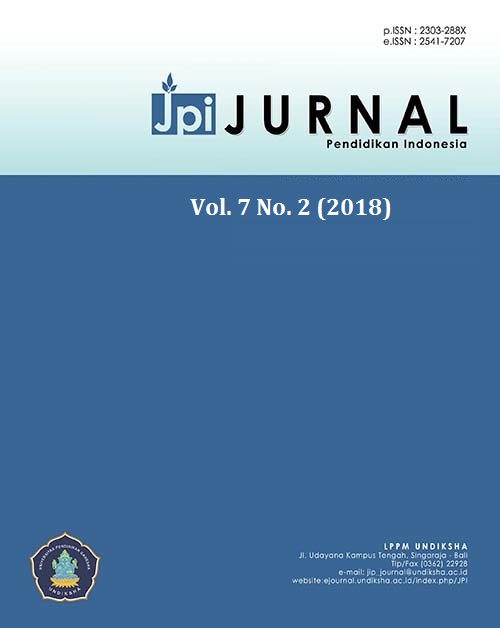The Development of Curved Side Constructions Learning Media Involving Problem Solving Capability and Local Culture Wisdom
DOI:
https://doi.org/10.23887/jpi-undiksha.v7i2.13742Keywords:
Curved Side Constructions, Problem Solving, Local Culture WisdomAbstract
The purpose of this study was to obtain a learning tool of curved side room learning materials based problem-solving ability and local cultural wisdom for students of class IX Junior High School in Merauke City that meet valid, effective, and practical criteria. This type of research is development research with 4D model design (Define, Designed, Develop, Disseminate). The subjects of the study were the students of class IX of SMP Negeri 9 Merauke. The resulting learning tools were tested and experimented using the posttest only control group design. The result of this research is obtained learning tools of curved side room learning-based problem-solving ability and local cultural wisdom that fulfill valid, practical, and effective criteria. Learning tools produced are student books, Student Activity Sheets (LKS), and Lesson Plans (RPP). The results of the device test show the students' mathematics problem-solving ability is better than the control class with an average score of 61.81 versus 52.57. Hypothesis testing using independent sample t-test shows Ho is rejected with the t count value of 3.049 which means that problem-solving ability using local culture learning tools is better using conventional learning devices.References
Akib, I. 2016. The Local Cultural Values In The Interaction of Mathematics Learning at School. IOSR-Journal of Mathematics. Volume 12, No. 4. Hal 24-28
Azwar, S. 2013. Tes Prestasi. Yogyakarta: Pustaka Pelajar.
Cheriani. Mahmud, A. Tahmir, S. Manda, D. Dirawan, G. 2015. Problem Based Learning Buginese Cultural Knowledge Model Case Study: Teaching Mathematics at Junior High School. Volume 8, No. 4. Hal 104-110.
Dewi, S. Sugiarti, T. Indah, K. 2015. Pengembangan Perangkat Pembelajaran Matematika Realistik Pada Pokok Bahasan Lingkaran Kelas VIII SMP. Jurnal Kadikma. Volume 6, No.1. Hal 85-94.
Kemdikbud. 2016. Indeks Integritas UN SMP/MTs Meningkat. Dipresentasikan dalam Konferensi Pers Pemaparan Hasil Ujian Nasional SMP 2016 di Jakarta Pada Tanggal 10 Juni 2016.
Muhassanah, N. Sujadi, I. Riyadi. 2014. Analisis Keterampilan Geometri Siswa Dalam Memecahkan Masalah Geometri Berdasarkan Tingkat Berpikir Van Hiele. Jurnal Elektronik Pembelajaran Matematika. Volume 2, No. 1. Hal 54-66.
Musser, G. Burger, W. Peterson, B. 2008. Mathematics For Elementary Teacher: A Contemporary Approach Eight Edition. New York: John Wiley & Sons, Inc.
Novotna, J, et.al. 2014. Problem Solving In School Mathematics Based On Heuristic Strategies. ERIES Journal. Volume 7, No. 1, Hal 1-6.
Nur, A.S & Palobo, M. 2017. Pengaruh Penerapan Pendekatan Kontekstual Berbasis Budaya Lokal Terhadap Kemampuan Pemecahan Masalah Matematika. Jurnal Aksioma. Volume 6, No. 1. Hal 1-14.
Nuha, M.A. Suhito. Masrukan. 2014. Analisis kemampuan pemecahan masalah geometri dan karakter Siswa Kelas VIII Melalui Pembelajaran Model 4K. Jurnal Kreano. Volume 5, No. 2. Hal 188-194.
OECD. 2016. PISA 2015 Results in Focus.
Pambudiarso, R.B. Mariani, S. Prabowo, A. 2016. Komparasi Kemampuan Pemecahan Masalah Materi Geometri antara Model SPS dan Model SPS dengan Hands on Activity. Jurna Kreano. Volume 7, No. 1. Hal 1-9.
Rohaeti, E. 2011. Transformasi Budaya Melalui Pembelajaran Matematika Bermakna di Sekolah. Jurnal Pengajaran MIPA, Volume 16, No. 1. Hal 139-147.
Saragih, S. Napitupulu, E.E. Fauzi, A. 2017. Developing Learning Model Based on Local Culture and Instrument for Mathematical Higher Order Thinking Ability. International Education Studies. Volume 10, No.6, Hal 114-122.
Downloads
Published
Issue
Section
License
Authors who publish with the Jurnal Pendidikan Indnesia agree to the following terms:
- Authors retain copyright and grant the journal the right of first publication with the work simultaneously licensed under a Creative Commons Attribution License (CC BY-SA 4.0) that allows others to share the work with an acknowledgment of the work's authorship and initial publication in this journal.
- Authors are able to enter into separate, additional contractual arrangements for the non-exclusive distribution of the journal's published version of the work (e.g., post it to an institutional repository or publish it in a book), with an acknowledgment of its initial publication in this journal.
- Authors are permitted and encouraged to post their work online (e.g., in institutional repositories or on their website) prior to and during the submission process, as it can lead to productive exchanges, as well as earlier and greater citation of published work. (See The Effect of Open Access)








